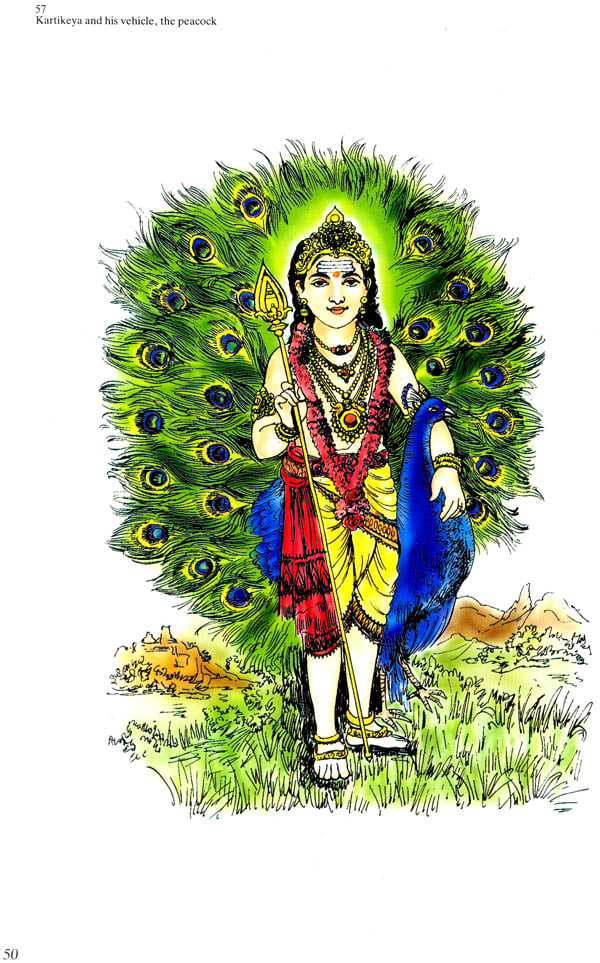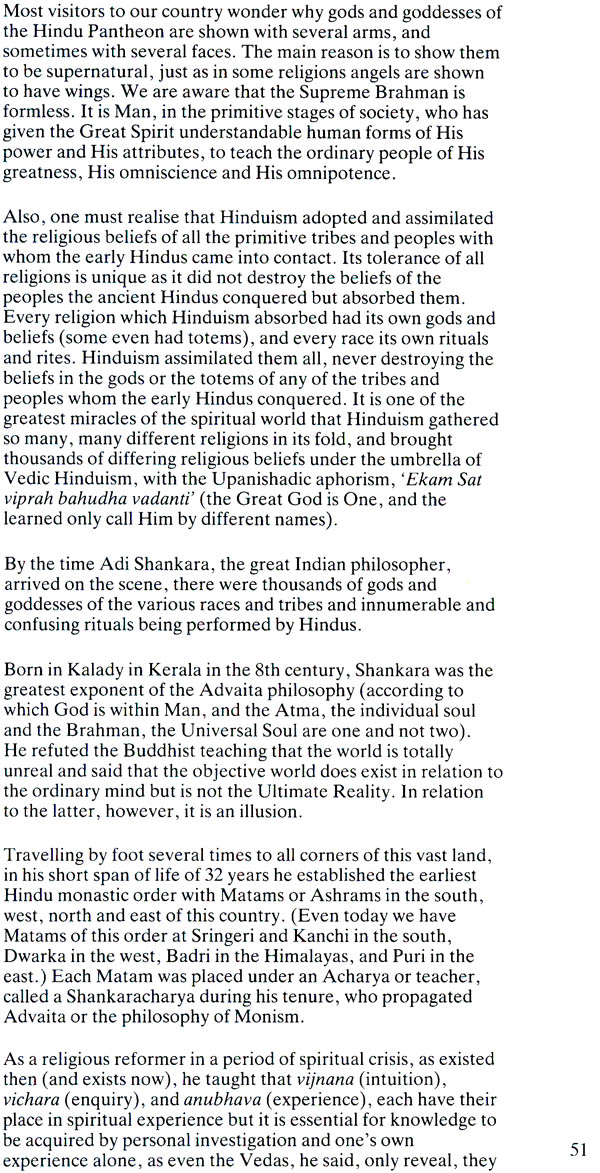
Hinduism: An Introduction
Book Specification
| Item Code: | IDC613 |
| Author: | Shakunthala Jagannathan |
| Publisher: | Vakils, Ferrer and Simons Pvt. Ltd. |
| Language: | English |
| Edition: | 2000 |
| ISBN: | 8184620214 |
| Pages: | 84 |
| Cover: | Paperback |
| Other Details | 11" x 8.5" |
| Weight | 400 gm |
Book Description
About The Book
Hinduism is the oldest living religion in the world and is unique in its tolerance of other religions. It offers different spiritual paths to persons of different aptitudes, and places emphasis on individual spiritual experience. Yet, in view of its free thinking and lack of compulsion, educated Hindus of today and Hindus living abroad know very little of their religion. There is, therefore, a great need for a simple but comprehensive book on the subject.
Likewise, tourists visiting India are often in search of a concise book which will help them understand the Hindu religion and guide them on their visits to Hindu temples and monuments.
Shakunthala Jagannathan has written this book to explain Hinduism to Indians and to visitors from abroad, so that the urban Indian can understand the roots of his civilisation, and the tourist can comprehend the various aspects of Hinduism and relate them to what he sees around him in India.
Many doubts such as the connection between the Universal Soul, the One God and the myriad gods and goddesses, Hindu rituals, practices and their symbolism, the Caste System, and concepts such as Karma, Dharma and reincarnation are explained in a simplified form.
Copiously illustrated, Hinduism, an Introduction, covers the various aspects of Hinduism, its main scriptures, tenets and beliefs, and its social and cultural ethos.
About the Author
The author, Shakunthala Jagannathan, was educated at Madras University and at Columbia University in New York, and worked with the United Nations before returning to India.
She joined the Department of Tourism Govt. of India in 1955, and retired as Deputy Director General and Regional Director. She received the PATA (India Chapter) Award of Merit in 1976 for her work in tourism.
Besides her book on Hinduism, she has written two books, India-Plan your own Holiday, and Ganesha, the Auspicious. ...the Beginning (the latter co-authored by her daughter, Nanditha Krishna).
She has been associated with various cultural and welfare organizations, and has been the President of the Altrusa Club of Bombay as also of Indus International and of the Asian Arts and Culture Centre, Bombay. Married to Mr. A. R. Jagannathan, she is the granddaughter of the late Dr. C. P. Ramaswamy Aiyar, renowned Indologist. Her father, Mr. C. R. Pattabhi Raman, has helped set up a foundation at Madras for the promotion of Indian Culture and the Arts, and her daughter, Dr. Nanditha Krishna, an art historian, is associated with its projects. Mrs. Jagannathan has been giving talks on Indian Culture to tourists and to students of training courses. It was while giving these lectures that she realized the need for a simple book explaining the Hindu way of life.
Preface
Some three years ago, a friend mentioned that his relatives living abroad wanted a simple but comprehensive book on Hinduism for their grown-up children, but he could not find one. I also agreed that foreign visitors to our country often asked for a guide book on the Hindu religion which they could understand and relate to what they saw in India. "Why don't you write one?" he asked, and from that was sown the germ of an idea.
Two years of research convinced me of the need for such a book, preferably illustrated (as none of the books in English covering all aspects of Hinduism is illustrated). However,, attempting to trace the thread connecting seemingly contradictory beliefs of this ancient religion, and transcribing it into book form was easier said than done. The greatest problem I faced was to decide what to leave out of this ocean known as Hinduism, so as to keep my book as brief as possible.
In this process several persons gave me invaluable help and I am deeply indebted to them. To mention a few to whom I owe eternal gratitude.
Jagadguru Shri Jayendra Saraswathi, the Shankaracharya of Kanchi, for encouraging me to write such a book.
To all those scholars, savants and men of religion whose books and studies guided my thinking.
To my father C.R. Pattabhi Raman, and friend, Navnitbhai Parekh, for their valuable suggestions on additions and deletions.
To Vimala Krishnamurti, who burnt midnight oil with me researching old scriptures, my mother Saraswathi, for the wealth of her Puranic lore, and my daughter, Nanditha Krishna, for vetting iconographical references.
To Page Mehta, R. Subbu, columnist RGK, and my uncle, P.C. Sekhar, for going through the manuscript.
To all those who assisted me in obtaining illustrations.
To T.S. Jaya, Ashok Sapre, P.A. Padmanabhan and S. Narayan for their valuable assistance.
And last but not the least, to G. U. Mehta and Arun and Sudha Mehta of Vakils for publishing this book.
To all of them and to many more, and to the Divine Will which prevented my giving up half-way (as I was often tempted to!), I am ever beholden.
| Preface | vi | |
| Blessings of Jagadguru Shankaracharya of Kanchi | vii | |
| Chapter I | What is Hinduism | 1 |
| Chapter II | The Scriptures of the Hindus | 5 |
| Srutis | 5 | |
| Smritis | 10 | |
| Epics | 11 | |
| Puranas | 20 | |
| Agamas | 28 | |
| Darshanas | 31 | |
| Chapter III | The Tenets and Beliefs of Hinduism | 35 |
| Nirguna Brahman | 35 | |
| Saguna Brahman | 36 | |
| Trinity | 36 | |
| Samsara | 54 | |
| Karma | 54 | |
| Dharma | 56 | |
| Caste System | 57 | |
| Status of Women | 60 | |
| Hindu Reform | 61 | |
| Four Stages of Life | 63 | |
| Yoga | 66 | |
| Vices and Virtues | 68 | |
| Three Paths to the Brahman | 70 | |
| Glossary and Index of Pronunciations | 82 | |
| Select Bibliography and Suggested Easy Reading | 84 |







